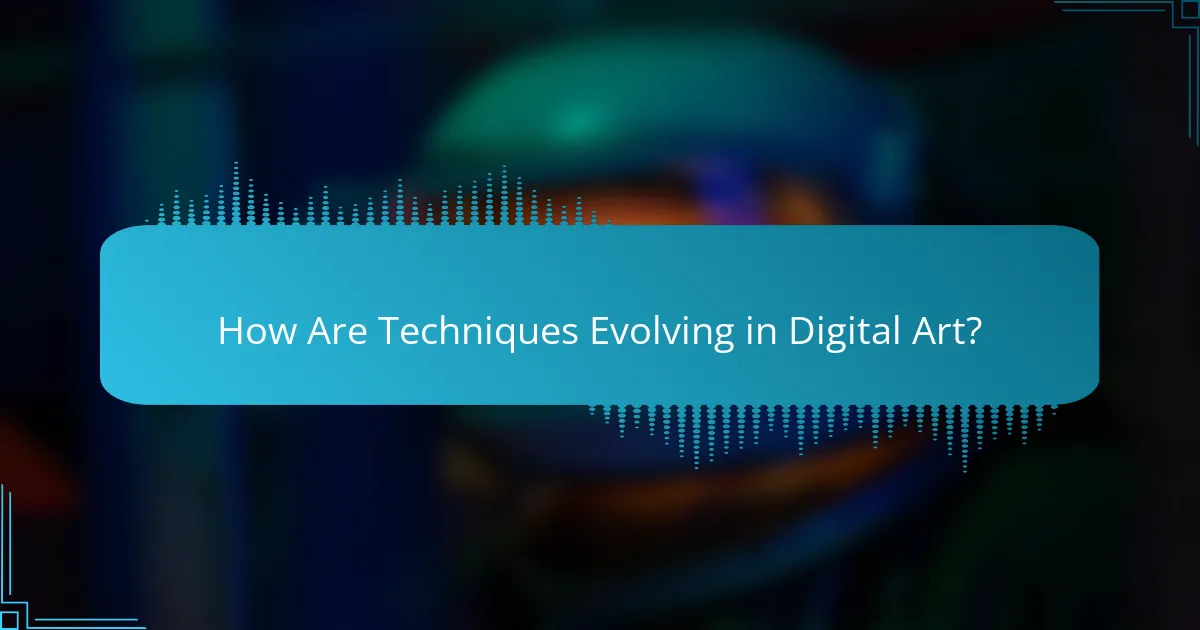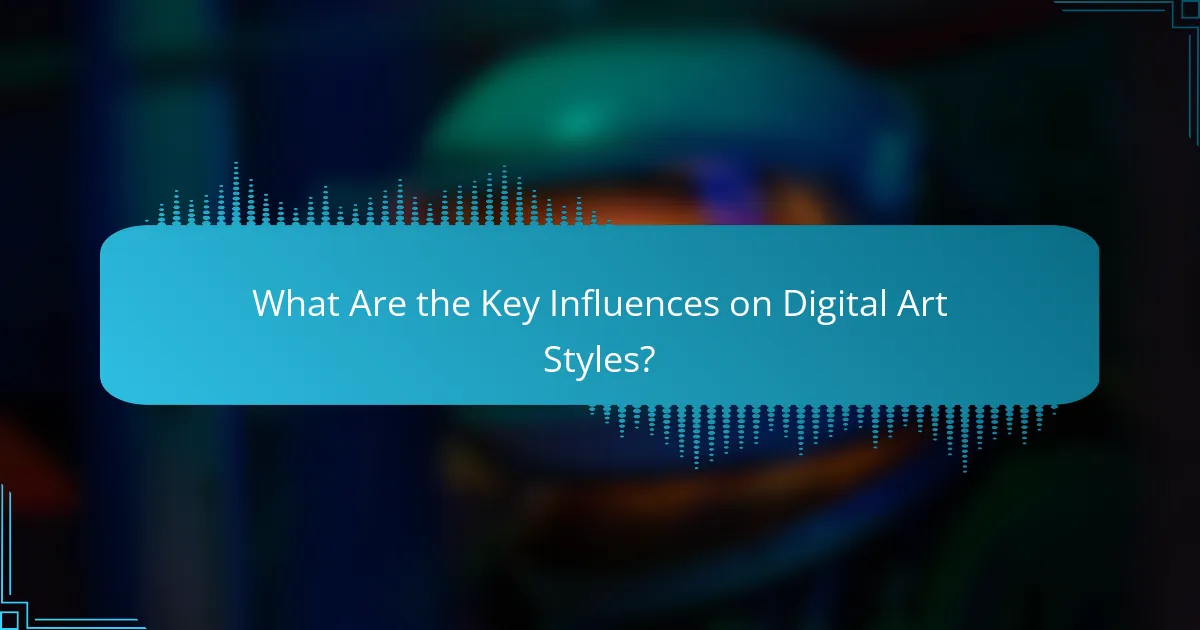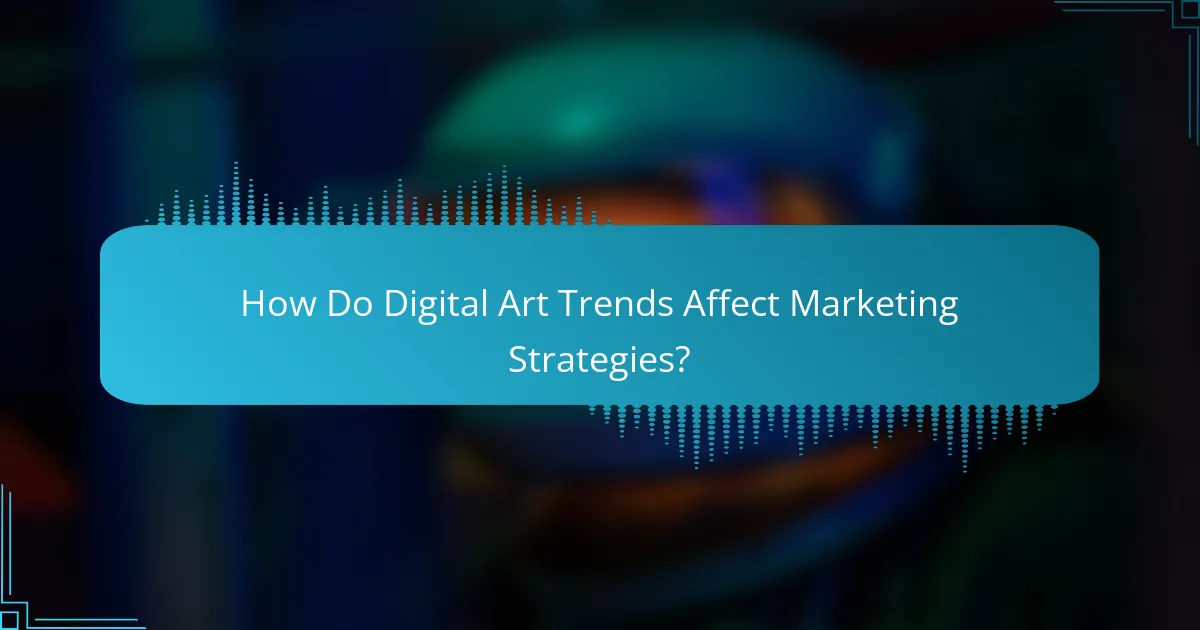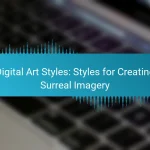The latest trends in digital art and graphic design highlight a dynamic interplay of innovation and creativity, with a strong emphasis on techniques that elevate visual storytelling. As artists embrace advancements in technology, they explore minimalism, augmented reality, and bold typography, while also integrating innovations like blockchain and generative art to redefine audience engagement and monetization.

What Are the Latest Digital Art Trends in Graphic Design?
The latest digital art trends in graphic design emphasize innovation and creativity, focusing on techniques that enhance visual storytelling. Key trends include minimalism, augmented reality, advancements in 3D design, bold typography, and the use of color gradients.
Minimalism in digital art
Minimalism in digital art prioritizes simplicity and functionality, stripping away unnecessary elements to focus on core messages. This trend often uses ample white space, limited color palettes, and clean lines to create impactful visuals.
Designers can achieve a minimalist look by selecting a few key elements and ensuring they serve a clear purpose. Avoid clutter and distractions to enhance user experience and engagement.
Augmented reality integration
Augmented reality (AR) integration in digital art allows designers to create immersive experiences that blend the digital and physical worlds. This trend is gaining traction as AR technology becomes more accessible through smartphones and tablets.
To effectively use AR, designers should consider user interaction and the context in which the art will be experienced. Incorporating AR can enhance storytelling and provide unique engagement opportunities, but it requires careful planning and execution.
3D design advancements
Advancements in 3D design are transforming how graphic designers create visuals, offering tools that enable more realistic and dynamic representations. Software like Blender and Cinema 4D allows for intricate modeling and rendering, making 3D art more accessible.
When incorporating 3D elements, designers should balance realism with artistic style. Consider how 3D components can enhance the overall design without overwhelming the viewer or detracting from the main message.
Bold typography usage
Bold typography is a prominent trend in digital art, with designers using striking fonts to capture attention and convey strong messages. This approach often involves oversized text and creative layouts that challenge traditional typography norms.
To effectively use bold typography, ensure that it complements the overall design and enhances readability. Experiment with different font weights and styles, but maintain a cohesive visual hierarchy to guide the viewer’s eye.
Color gradients and duotones
Color gradients and duotones are increasingly popular in digital art, adding depth and vibrancy to designs. These techniques allow for smooth transitions between colors, creating visually appealing backgrounds and elements.
When using gradients, consider the emotional impact of color combinations and how they relate to the overall message. Duotones can simplify complex images while maintaining visual interest, making them a versatile choice for various applications.

How Are Techniques Evolving in Digital Art?
Techniques in digital art are rapidly evolving, driven by advancements in technology and changing artistic trends. Artists are increasingly adopting new tools and methods that enhance creativity, streamline workflows, and produce innovative results.
AI-assisted design tools
AI-assisted design tools are transforming the landscape of digital art by automating repetitive tasks and offering intelligent suggestions. These tools can analyze existing designs and generate new ideas, allowing artists to focus on the creative aspects of their work.
Popular AI tools, such as Adobe Sensei and Canva’s Magic Write, help streamline processes like image editing and layout design. Artists should consider integrating these tools into their workflow to increase efficiency and explore new creative possibilities.
Vector graphics innovation
Vector graphics are experiencing significant innovation, particularly with the introduction of new software and techniques that enhance scalability and flexibility. Modern vector tools allow for more complex designs while maintaining high-quality output across various sizes.
Programs like Adobe Illustrator and Affinity Designer now offer advanced features such as variable width strokes and gradient meshes, enabling artists to create intricate designs. Embracing these innovations can lead to more dynamic and visually appealing artwork.
Motion graphics popularity
Motion graphics are becoming increasingly popular in digital art, driven by the demand for engaging visual content across platforms. This trend is evident in advertising, social media, and entertainment, where animated graphics capture audience attention more effectively than static images.
Artists can utilize tools like After Effects and Blender to create captivating motion graphics. To succeed in this area, focus on storytelling and pacing, ensuring that animations enhance the message rather than distract from it.

What Innovations Are Shaping the Future of Digital Art?
Innovations such as blockchain technology, interactive installations, and generative art are significantly influencing the future of digital art. These advancements not only enhance creativity but also redefine how artists engage with their audiences and monetize their work.
Blockchain and NFTs
Blockchain technology and non-fungible tokens (NFTs) are revolutionizing the way digital art is bought, sold, and owned. By providing a secure and transparent method for verifying ownership, artists can sell their work directly to collectors without intermediaries.
Artists should consider the environmental impact of blockchain transactions, as some platforms consume substantial energy. Choosing eco-friendly blockchains or participating in carbon offset programs can mitigate this concern.
Interactive installations
Interactive installations blend digital art with audience participation, creating immersive experiences. These installations often utilize sensors and software to respond to viewer movements or inputs, making the art dynamic and engaging.
When designing interactive art, consider the user experience. Ensure that the technology enhances rather than distracts from the artwork. Testing with diverse audiences can provide valuable feedback for improvement.
Generative art technologies
Generative art technologies use algorithms and code to create unique artworks, often in real-time. This approach allows for endless variations and can produce art that evolves based on user interaction or environmental data.
Artists exploring generative art should familiarize themselves with programming languages like Processing or p5.js. Collaborating with technologists can also expand creative possibilities and enhance technical execution.

What Are the Key Influences on Digital Art Styles?
Digital art styles are significantly shaped by various influences, including pop culture, social media, and global art movements. These elements contribute to the evolution of techniques and aesthetics in the digital art landscape.
Pop culture references
Pop culture references play a crucial role in shaping digital art styles by providing relatable themes and imagery. Artists often draw inspiration from movies, music, and television, integrating recognizable elements into their work to resonate with audiences.
For instance, the use of iconic characters or symbols from popular franchises can instantly attract attention and create a connection with viewers. This trend encourages artists to stay updated on current pop culture phenomena to keep their work relevant.
Social media impact
Social media has transformed how digital art is created, shared, and consumed. Platforms like Instagram and TikTok allow artists to showcase their work to a global audience, leading to rapid feedback and trends that influence artistic styles.
Artists often adapt their techniques to fit the visual preferences of social media users, such as creating eye-catching thumbnails or short videos that highlight their creative process. This responsiveness to audience engagement can significantly impact an artist’s visibility and success.
Global art movements
Global art movements, such as surrealism, minimalism, and street art, have a lasting influence on digital art styles. These movements introduce unique philosophies and techniques that artists can incorporate into their digital creations.
For example, the rise of street art has led to a surge in graffiti-inspired digital works, while minimalism encourages artists to focus on simplicity and clean lines. Understanding these movements can help artists develop their own distinctive styles while paying homage to established traditions.

How Do Digital Art Trends Affect Marketing Strategies?
Digital art trends significantly influence marketing strategies by shaping how brands communicate visually with their audiences. By leveraging contemporary design techniques, marketers can create compelling narratives that resonate with consumers and enhance brand engagement.
Visual storytelling techniques
Visual storytelling techniques involve using images, graphics, and animations to convey a narrative or message effectively. This approach captures attention and fosters emotional connections, making it a powerful tool in marketing. Brands can utilize infographics, video animations, and interactive content to illustrate their stories and engage their audience.
To implement visual storytelling, consider the following steps: identify your core message, choose appropriate visuals that align with your brand, and ensure a cohesive narrative flow. For example, a brand launching a new product might create a short animated video that highlights its features through a relatable story.
Brand identity through digital art
Digital art plays a crucial role in establishing and maintaining brand identity. Consistent use of colors, typography, and graphic styles helps create a recognizable brand image that resonates with consumers. This visual consistency across platforms reinforces brand values and fosters loyalty.
When developing brand identity through digital art, focus on creating a unique visual style that reflects your brand’s personality. Avoid common pitfalls such as overcomplicating designs or using too many different styles, which can dilute brand recognition. A well-defined style guide can help ensure consistency in all marketing materials.


